I’ll cut to the chase: if you’re battling hard water that’s wrecking your appliances, drying out your skin, or leaving your dishes spotty, the Novo water softener is a game-changer you need in your home.
After wrestling with limescale buildup and lackluster laundry, I invested in a Novo, and it’s been a revelation. This article walks you through my real-world experience, the standout benefits, the not-so-great bits, and how to keep it running smoothly.
By the end, you’ll see why Novo is worth your attention and how it stacks up against the competition. Trust me, your pipes will thank you.
My Journey With The Novo Water Softener
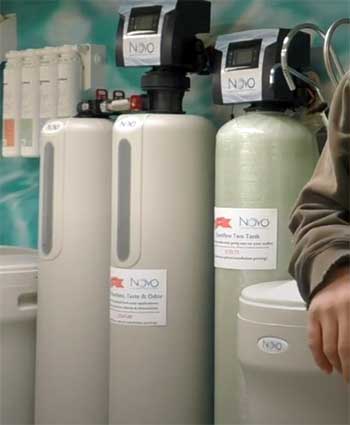
When I moved into my new home in a hard water area, I didn’t realize how much trouble those sneaky minerals like calcium and magnesium would cause.
My faucets were crusty, my skin felt like sandpaper after showers, and my coffee maker was practically begging for mercy.
I knew I needed a water softener, but with so many brands out there, I felt overwhelmed.
After researching and talking to a local plumber, I landed on the Novo 485HE, a high-efficiency salt-based model that promised to tackle my water woes without breaking the bank.
Installing the Novo was surprisingly straightforward. My plumber, who’s installed dozens of these, had it up and running in a few hours. The unit’s compact design fit neatly in my garage, and I appreciated that it didn’t demand a ton of space.
Right after installation, I noticed a difference. My water felt silkier, and my shampoo lathered like I was in a commercial. Dishes came out of the dishwasher without those annoying white spots, and my laundry felt softer, not like it had been starched within an inch of its life.
Over the first month, I kept an eye on the system. The digital display was a lifesaver, showing me when to add salt and when a regeneration cycle was coming up. I used about one 40-pound bag of salt, which felt reasonable for my four-person household.
The water hardness dropped from a gritty 15 grains per gallon (GPG) to a dreamy 2 GPG, confirmed by test strips. The only hiccup?
Figuring out the right salt amount initially was a bit of trial and error, but once I got the hang of it, the Novo ran like a champ. It’s been six months, and I’m hooked on the softer water and the peace of mind knowing my appliances are protected.
Pros of The Novo Water Softener
- High Efficiency Saves You Money
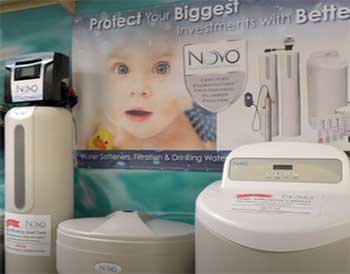
The Novo 485HE is a penny-pincher’s dream.
Its upflow regeneration and precision brining use up to 75% less salt and 64% less water compared to traditional models.
In my home, this translated to about $50 in annual savings on salt alone, based on my usage of one bag per month at roughly $8 a bag.
The system’s “Smart Clean Mode” is a standout, automatically flushing stagnant water if I don’t use it for seven days—perfect for when I’m on vacation. This efficiency doesn’t just save cash; it’s kinder to the environment, reducing wastewater and salt discharge.
- Easy Installation and Compact Design
You don’t need to be a plumbing wizard to get the Novo set up. My plumber praised its straightforward installation, and I’ve heard from others that DIYers can handle it with basic tools and the manual. The unit’s compact size—about 15 x 48 x 20.5 inches for the 485HE—means it doesn’t hog space in your garage or utility room.
For smaller homes or apartments, Novo’s EcoSmart model is even more space-friendly, fitting into tight spots like under a sink. This flexibility makes it a practical choice no matter your living situation.
- Reliable Performance for Hard Water
Novo delivers where it counts: softening tough water. My home’s water tested at 15 GPG, which is pretty hard, and the Novo brought it down to near-zero hardness levels. This isn’t just about feeling good in the shower; it protects your pipes, water heater, and appliances from scale buildup.
The 485HE’s 40,000-grain capacity handles my family’s needs, and for larger households, Novo offers models like the 85TA with higher capacities. Plus, it’s NSF/ANSI 44 certified, so you know it’s legit for material safety and performance.
- Smart Features for Hassle-Free Use
The digital display and metered regeneration make the Novo feel like a modern gadget. You can customize settings to match your water usage, and the system only regenerates when needed, not on a rigid schedule.
This meant fewer regeneration cycles—about once a week for me—saving water and salt. The “Soft Water Recharge Mode” ensures consistent soft water even during heavy use, like when I had guests over for a weekend. It’s like the system thinks for itself, taking the guesswork out of maintenance.
- Eco-Friendly Approach
If you’re eco-conscious like me, you’ll appreciate Novo’s efforts to cut waste. The upflow regeneration minimizes salt and water use, and the system’s fiberglass pressure tank is durable, reducing the need for replacements.
Unlike some brands that churn out salty wastewater like it’s going out of style, Novo’s efficiency means less environmental impact. It’s not perfect—salt-based systems still produce some wastewater—but it’s a step in the right direction for those who want softer water without feeling guilty about the planet.
Not-So-Good Parts of The Novo Water Softener
- Initial Cost Can Sting
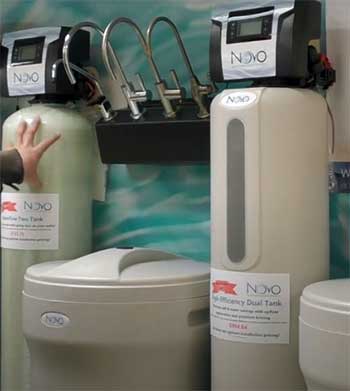
Let’s be real: the Novo isn’t cheap upfront.
My 485HE cost around $800, not including installation, which added another $200.
Compared to budget models like the Fleck 5600SXT, which can go for $600, it’s a bit of a splurge.
For smaller budgets, this might feel steep, especially if you’re in a small home and don’t need all the bells and whistles.
That said, the long-term savings on salt and water do help offset the cost over time, but it’s still a hit to the wallet initially.
- Salt-Based Maintenance Isn’t for Everyone
If you’re hoping for a maintenance-free life, the Novo’s salt-based system might disappoint. You’ll need to check the brine tank every 4-6 weeks and lug 40-pound salt bags to keep it topped up.
For me, this isn’t a huge deal—I’m used to it now—but if you have mobility issues or just hate regular upkeep, a salt-free system like NuvoH2O might be more your speed. The Novo does require less salt than older models, but it’s still a commitment.
- Limited Availability and Proprietary Parts
One frustration I ran into was finding Novo products. They’re sold exclusively through authorized dealers, which means you can’t just pop onto Amazon and grab one. This limited availability can make pricing less transparent, as you’re at the mercy of local plumbers or distributors.
Also, some components, like the control valve, are proprietary, so repairs might mean dealing directly with Novo or their dealers. This isn’t a dealbreaker, but it’s less convenient than brands like Fleck, which use widely available parts.
- Not Ideal for Extremely Hard Water Without Add-Ons
While the Novo 485HE handled my 15 GPG water like a pro, if your water is pushing 20 GPG or higher, you might need a dual-tank model like the 485 HEDP for consistent softening.
My single-tank system occasionally struggled during peak usage, like when everyone was showering and the dishwasher was running. Adding a second tank or a pre-filter for sediment or iron bumps up the cost and complexity, which might not suit everyone.
Maintenance Tips For Your Novo Water Softener
- Keep the Brine Tank Stocked
Your Novo’s brine tank is the heart of its softening magic, so don’t let it run low on salt. I check mine every 4-6 weeks, aiming to keep it at least half-full with high-quality water softener salt pellets.
A 40-pound bag lasts me about a month, but your usage will depend on your water hardness and household size. If the salt level drops too low, the system can’t regenerate properly, and you’ll notice hard water creeping back. Pro tip: use a salt level indicator if your model has one—it’s like a fuel gauge for your softener.
- Clean the Resin Tank Periodically
Every 3-4 months, I give my Novo’s resin tank a quick clean to prevent mold or mildew buildup. The process is simple: empty the brine tank, scrub it with soapy water, rinse, and add a quarter-cup of bleach mixed with water. Let it sit for 15 minutes, then rinse again and refill with salt.
This keeps the system hygienic and ensures the resin beads work efficiently. Novo recommends a cleaning solution for this, which I found easy to use, but regular dish soap works in a pinch.
- Monitor Regeneration Cycles
The Novo’s metered regeneration is a lifesaver, but you still need to keep an eye on it. My 485HE regenerates about once a week, but if you notice hard water symptoms—like spotty dishes or dry skin—it might be regenerating too infrequently.
You can adjust the settings via the digital display to match your water usage. I learned to check the display for error codes if something feels off; they’re super helpful for troubleshooting. If you’re going on vacation, set the system to “vacation mode” to avoid unnecessary cycles.
- Check for Leaks and Blockages
After installation, I made it a habit to inspect the Novo for leaks or blockages every couple of months. Look at the connections to your plumbing and the bypass valve for any drips. If you have well water with iron or sediment, consider adding a pre-filter to prevent clogs in the resin tank.
My plumber caught a small leak early on, which was just a loose fitting, so staying proactive saves you from bigger headaches down the line.
- Schedule Professional Checkups
While the Novo is low-maintenance, I recommend a professional checkup every 1-2 years. My plumber inspects the control valve and resin bed to ensure everything’s in top shape. The resin typically lasts 5-10 years, but heavy use or high chlorine levels can wear it out faster.
A pro can spot issues like resin degradation or valve wear before they become costly. This might cost $100-$150, but it’s worth it to extend the system’s 10-15 year lifespan.
Comparison of Novo Water Softener With Other Brands
Let’s see how the Novo 485HE holds up against three other big names in water softening: RainSoft, Morton, and Marlo. I’ve broken it down into key areas to help you decide which system fits your home best.
- Novo Vs. RainSoft: Efficiency and Cost
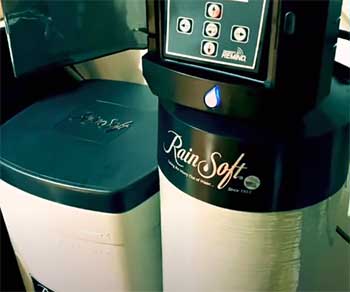
RainSoft’s EC5 series is a high-end salt-based softener, priced around $2,000-$3,000, dwarfing my Novo’s $800 price tag.
RainSoft boasts advanced features like Wi-Fi monitoring and a carbon filter for taste, which Novo lacks.
However, RainSoft’s regeneration uses more water—about 30 gallons per cycle compared to Novo’s 10-15—and its salt consumption is higher, around 1.5 bags a month for my 15 GPG water.
Novo’s upflow regeneration and “Smart Clean Mode” make it more efficient, saving me $50-$70 yearly on salt.
RainSoft’s premium features are nice, but for budget-conscious folks like me, Novo delivers solid softening at a fraction of the cost.
- Novo Vs. Morton: Installation and Maintenance
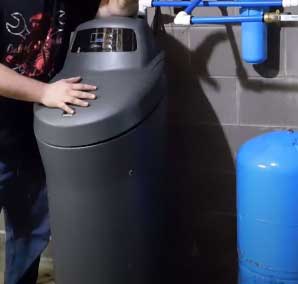
Morton’s System Saver, priced at $600-$900, is close to Novo in cost and popular for its reliability.
Installation for both is DIY-friendly, but Morton’s bulkier design (18 x 52 inches) took up more space in my friend’s basement compared to Novo’s compact 15 x 48 inches.
Morton’s timer-based regeneration is less efficient, using 20-25 gallons per cycle and regenerating every few days regardless of usage.
Novo’s metered system regenerates only when needed—once a week for me—saving water and salt.
Morton’s simpler controls are less user-friendly than Novo’s digital display, which I found intuitive for tweaking settings. If space and efficiency matter, Novo edges out Morton.
- Novo Vs. Marlo: Performance and Durability
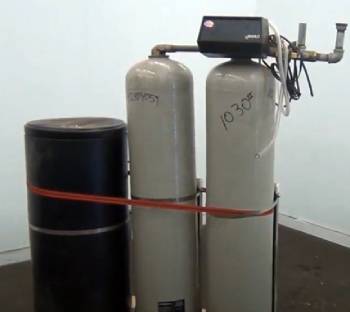
Marlo’s MST series, priced around $1,200, is a heavy-duty softener built for tough water, with a 10% crosslink resin that outlasts Novo’s standard resin (10-15 years vs. 5-10).
Marlo’s 48,000-grain capacity slightly tops Novo’s 40,000, making it better for larger households.
However, Marlo’s downflow regeneration uses more salt (1.2 bags a month) and water (25 gallons per cycle) than Novo’s upflow system.
My 15 GPG water was no match for Novo, dropping to near-zero hardness, and its NSF/ANSI 44 certification matches Marlo’s for safety.
Marlo’s tank is steel, not fiberglass like Novo’s, which can rust over time. For my needs, Novo’s performance and lighter maintenance win.
- Novo Vs. All Three: Features and Accessibility
Novo’s smart features, like metered regeneration and “Soft Water Recharge Mode,” keep it competitive. RainSoft’s Wi-Fi app is fancier, but Novo’s digital display is plenty for me. Morton’s basic controls feel dated, and Marlo’s manual settings require more tinkering than Novo’s automated system.
Accessibility is a pain point for Novo—sold only through dealers, like RainSoft, which can mean higher markups. Morton’s widely available at hardware stores, and Marlo’s sold direct or via dealers, offering more flexibility.
Still, Novo’s balance of modern features and efficiency makes it a strong choice for my city water setup.
In the end, Novo shines for efficiency and ease of use. RainSoft’s premium price doesn’t justify its thirstier cycles for me, Morton’s dated tech falls short on savings, and Marlo’s durability comes with higher maintenance.
If you want a reliable, eco-friendly softener without breaking the bank, Novo’s your best bet.
Frequently Asked Questions (FAQs)
Choosing the “best” brand depends on your needs, but Novo holds its own for efficiency and reliability. For budget shoppers, Fleck’s 5600SXT is a steal with widely available parts. Aquasure excels for well water, while SpringWell’s smart features appeal to tech lovers. NuvoH2O is great for low-maintenance, salt-free systems but less effective for very hard water. I picked Novo for its balance of cost, performance, and eco-friendly features, making it a top contender for city water households like mine.
The Novo 485HE uses metered regeneration, so it regenerates based on your water usage, not a fixed schedule. In my home, with 15 GPG water and four people, it regenerates about once a week, using 10-15 gallons of water per cycle. You can tweak the settings to optimize this, and the “Smart Clean Mode” kicks in every seven days of no use to prevent bacteria buildup. Your frequency will vary with water hardness and household size.
Novo offers a 10-year warranty on most models, including the 485HE, covering the tank and control valve. This gave me peace of mind, as it matches industry leaders like Fleck and SpringWell. The resin bed typically lasts 5-10 years, but the warranty doesn’t cover wear from high chlorine or improper maintenance. Check with your dealer for specifics, as terms can vary slightly depending on the model and region.
Aquasure’s Harmony Series is solid, especially for well water with iron or large households. Its 48,000-grain dual-tank model ensures continuous soft water, and it handles up to 15 GPG well. However, it’s bulkier and uses more salt than my Novo 485HE—about 1.5 bags a month versus my one bag. Installation can be trickier, and some users report spotty customer service. If you need iron removal or have high water demand, Aquasure’s a great pick, but for city water, I found Novo more efficient.
Conclusion: Why Novo Is Your Best Bet?
After six months with the Novo water softener, I’m sold. It’s transformed my home’s water, saving my appliances and making showers feel luxurious. The efficiency, compact design, and smart features make it a standout, despite the upfront cost and salt maintenance.
Compared to Fleck, Aquasure, SpringWell, and NuvoH2O, Novo hits the sweet spot for most households. If you’re ready to say goodbye to hard water woes, grab a Novo—you’ll wonder why you waited so long. Your skin, dishes, and wallet will thank you.
